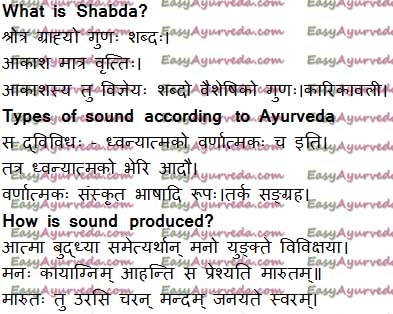Mechanism Of Production Of Sound – Ayurveda Perspective
By Dr Raghuram Y.S. MD (Ay) & Dr Manasa, B.A.M.S
Sound is the sense object of sense organ of hearing i.e. ear. Sound is one of the sources of learning and obtaining the knowledge of things. Sound is known as Shabda guna / Shabda tanmatra in Ayurveda.
Read – Jnana and Karma Indriyas: Organs Of Sense And Function
Table of Contents
Introduction
Sound (shabda) is one of the special qualities (vishishta gunas). Other special qualities are touch, sight, taste and smell, the objects of other sense organs. These special qualities are types of Adhibhoutika qualities.
It is also counted as one among the five tanmatras and is involved in the creation of the universe. Other tanmatras are touch, sight, taste and smell.
Read – Indriya Pancha Panchaka: 5 Fives Of Sense Organs
What is Shabda?
Sound (shabda) is the quality which is perceived by sense organ of sound (shrotra indriya) i.e. ear.
Sound is a quality of space element. Sound is present in the space and is related to it in an inseparable relationship. Ear is predominantly made up of space element. Therefore the sense organ of hearing (ear) is also related to the sound quality embedded in the ether element.
Sound (shabda) is the special quality (vaisheshika guna) of ether element.
Read – Akasha Mahabhuta: Qualities, Functions, How To Balance
Types of sound
Types of sound according to Ayurveda
According to Ayurveda, the sound is of two types.
Varnatmaka
Varnatmaka Shabda –
This form of sound is produced from vocal sounds, when we speak, in the form of words of different languages. These sounds are called pronounced / vocal sounds.
Dhvanyatmaka
Dhwanyatmaka Shabda – This form of sound is produced from musical instruments like drums, conch etc.
Read – Panchamahabhuta: Application, Areas of Utility in Ayurveda treatment
Sound production mechanism
How is sound produced?
1. Mechanism of production of Varnatmaka Shabda – the vocal sounds
Vocal sounds are produced when there is a desire to speak or tell something. This desire has its origin in the soul (atma). We might have observed that we are raring to speak at times and many times we do not have the will to speak. Wanting to speak and not wanting to tell something is due to the desire generated in the soul.
Read – Importance Of Soul In Perception Of Knowledge: Atma Jnana
When the soul desires to express something, it has to produce sounds which could convey things. Therefore it associates itself with intellect (buddhi) and stimulates the mind. The stimulated mind then gets associated with belly fire (kayagni). This in turn stimulates vata.
Vata moving in the chest region produces sounds /words. Vata moving in the upward direction in the chest makes contact with throat, palate and lips, generates activities in them and produces varnatmaka sounds. Thus we speak.
Read – Role of Vata Dosha And Its Types In Speech And Voice
2. Mechanism of production of Dhwanyatmaka Shabda – the instrumental sounds
Instrumental sounds (dhwanyatmaka shabda) are produced as a result of association and dissociation.
Example, sound is produced due to association of drum and stick. When a stick strikes the drum, there is association of stick and drum and this produces sound.
Similarly sound is also produced due to the splitting / breaking / dissociation of a bamboo etc. When we break a bamboo, there is dissociation and this produces sound of breaking.
Read – Relation Between Doshas, Sense Organs And Perception
Vachi Taranga Nyaya
Vachitaranga Nyaya – production of successive sound waves
Production of one sound from other takes place on the basis of vachitaranga nyaya logic. When the manifestation of one sound wave (taranga) takes place, the second, third etc waves follow it and are consecutively produced one after the other with simultaneous destruction / disappearance of their former sound waves. This is quite similar to water waves.
Read – What Is Mind, Sense Organs? Charaka Samhita Sutrasthana 8th Chapter
When we have waves in water, the first wave gives way to second and the second to the third wave, i.e. when the first wave gets destroyed i.e. disappears, only then the second wave is produced. When the second wave is destroyed, the third wave is produced.
Similarly the sound waves are transmitted from one place to the other on the basis of the same principle i.e. vachi taranga nyaya producing their successive sounds. Even here, the consecutive waves of sound are produced when their former waves are destroyed / disappear.
Read – Improper Use Of Sense Organs: A Neglected Cause For Diseases
Sanskrit Verse – Shloka

Sound waves strength
Strength of sound and sound waves
For a sound to be produced, it should have strength (shakti). If there is no strength in the sound wave, it is not produced, just like we cannot speak loudly or cannot produce sounds as we try to speak after fasting or when we are thirsty for a long time.
Thus, the formation of one sound after the other takes place until the strength is present in the sound. If the sound lacks strength, the consecutive sound waves are not produced. As a result the speech becomes unclear and thus sound is not perceived. Thus, production of sound and its perception depends on the strength the sound waves carry.
Click to Consult Dr Raghuram Y.S. MD (Ayu) – Email / Skype







